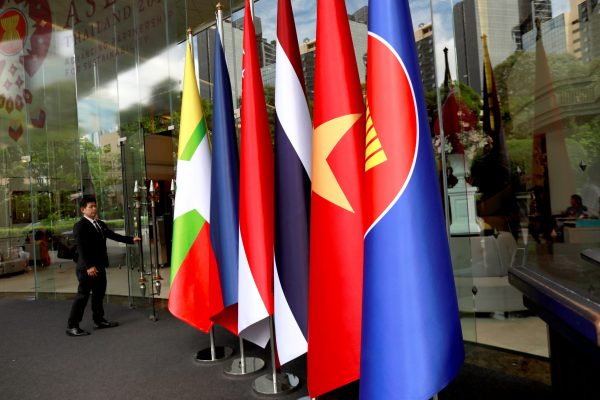The actions of the United States were arbitrary, to say the least, and have rocked global financial markets. The recent ‘ASEAN Outlook on the Indo-Pacific’ shows that ASEAN countries are more and more wary of the approach being taken by the United States in the region. They are right to be worried.
Labelling China a currency manipulator made little sense, both economically and institutionally.
Economically, a weakening RMB is to be expected in the current economic circumstances. The Chinese economy has been slowing while the United States continues its longest economic boom in history. Chinese exports to the United States have been under increasing strain while escalating global risks have seen increased demand for safe haven US financial assets. All of these variables point to a weakening RMB against the US dollar. ‘They are not driving the currency down’ notes Marc Chandler, Chief market strategist at Bannockburn Global Forex, ‘but just accepting market forces’. Within a narrow band the Chinese monetary authorities let the currency settle where the market took it.
Institutionally, China’s actions fail to satisfy the US Treasury’s own definition of a currency manipulator. ‘China has not been intervening’ says Mark Sobel, a 40-year US Treasury veteran. ‘By Treasury’s own foreign exchange report criteria, China doesn’t even come close to meeting the terms for manipulation’. The IMF has similarly judged that China’s exchange rate in 2018 was broadly in-line with its fundamentals, and has reached the same conclusions for at least the last 5 years.
Is a currency war brewing?
It is unlikely that the Trump administration would be able to achieve the President’s wish of a lower US dollar. Trump could use the Treasury’s Exchange Stabilization Fund to start selling US dollars. But with only US$100 billion in the fund, and dollar holdings of just US$23 billion, it is unlikely to be large enough to achieve any sustained depreciation of the US dollar. This means that any sustained reduction in the US dollar would require action from the US Federal Reserve which, thus far, has held its ground.
Although US institutions will slow the outbreak of a currency war, President Trump does have the power to impose further trade restrictions and sanctions on China. But as the IMF has shown, these costs fall overwhelmingly on US consumers, suggesting that a US recession may be the most likely path for the President in achieving a fall in the US dollar, particularly as the US yield curve inverted significantly last week — a reliable predictor of US recessions.
Last week’s currency tensions also say something important about China. By allowing the RMB to fall below the 7 yuan-per-dollar level, China is perhaps demonstrating some newfound economic confidence and independence. The 7 yuan-per-dollar level was seen by many as an important psychological threshold. Allowing the RMB to fall below it signals an increased willingness of Chinese authorities to behave more independently relative to what the rest of the world is doing.
Whether this newfound financial independence will amount to any structural changes in the Chinese monetary policy and exchange rate framework is still unclear. What is clear is that US foreign policy towards China has entered a new frontier. Twelve months ago, the concern was about the trade war. The concerns then shifted into technology and firms and have now shifted into currencies and financial markets.
Southeast Asian countries are watching, nervously. After more than a year of deliberation, ASEAN adopted the ‘ASEAN Outlook on the Indo-Pacific’ (‘the Outlook’) on 23 June 2019. The Outlook is essentially a guide to how ASEAN sees the Asia Pacific and its engagement therein.
As Amitav Acharya discusses in this week’s lead essay, the Outlook tells us a lot about how ASEAN, particularly Indonesia (which took the lead in conceiving the plan) thinks about the concept of the ‘Indo-Pacific’ and the approach being taken by the US in Asia.
Acharya argues that Indonesia is uncomfortable with the US approach to the concept of the Indo-Pacific, seeing it as exclusionary and aimed at isolating China. In response, Jakarta has been developing an ASEAN-centred Indo-Pacific strategy that is more consistent with ASEAN’s principles of inclusiveness (towards China too), consensus-building, and with its stress on a normative, political and diplomatic — rather than an excessively military–strategic — approach.
Acharya shows how the differences between the ASEAN and US approaches are captured in the terminology used by the two countries to articulate their Indo-Pacific visions. ‘The United States wants a ‘free’ and ‘open’ Indo-Pacific, echoing the wording used by Japan’s Prime Minister Shinzo Abe, but with a more overt military–strategic orientation’ says Acharya. ‘In comparison, Indonesia seeks an ‘open’ and ‘inclusive’ Indo-Pacific. The United States does not use ‘inclusive’ while Indonesia does not use ‘free’’.
This ASEAN-speak may appear semantic, but its significance is substantial. What the Outlook shows is that ASEAN is playing its classic role as a regional consensus-builder. This is needed now more than ever. As US–China tensions continue to move through trade, technology, currencies and finance, Asia will be left footing the costs. Building consensus and addressing the root causes of tensions by reforming global rules and institutions requires Asian leadership and the engagement of China, not its isolation. Remaining on the sidelines has not worked thus far. It is unlikely to work in the future.
The EAF Editorial Board is located in the Crawford School of Public Policy, College of Asia and the Pacific, The Australian National University.

